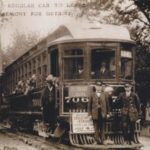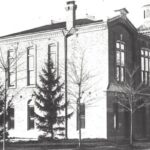On December 9, 1881, the Union School building, which was constructed in 1867, burned.
After the Civil War, the State of Michigan began a reorganization of the State’s school system. As part of that reorganization, a Union School District was created for Almont. A brick school building was built on Church Street at the end of Centennial Avenue. This was a kindergarten to grade twelve building.
The building was an elegant and substantial two-story brick, which was designed by G. W. Lloyd of Detroit. It measured 60 by 80 feet on the ground. The building was 43 feet from ground level to the cornice, 64 foot to the top of the chimneys, and 90 feet to the top of the bell tower. Over 375,000 bricks were used in the school’s construction. The building was well finished throughout.
In the countryside, one-room schools where operated to teach children from kindergarten to eighth grade. Children from the countryside, who attended the system of one-room schools, could come into town to attend high school.
The school’s first principal was A. J. Itsell. The high school teachers were Miss M. C. Smith and Miss Helen J. Palen. Miss Amanda Bishop and Miss Louisa Kahler were the intermediate grade teachers. The primary grades were taught by Miss Amelia Dickerson.
The Board of Education members were J. S. Johnson – Moderator, D. W. Richardson – Director, John Wright – Assessor, E. B. Hough, J. Simon, and J. S. Jenness – Trustees.
Tuition for a twelve week term was $2.00 for primary grades, $2.50 for intermediate grades, and $4.00 for high school.
In an article in the Almont Herald (predecessor of the Tri-City Times) Frank M. Johnson of Lowell wrote; “Our school is not surpassed in any like village in the State, yet it is with deep regret we find very many parents neglecting to give their children the benefit of such educational facilities.”
On December 9, 1881, at about half past seven o’clock, light was observed in the basement windows and the alarm was raised. People rushed to the school ground with pails and began a bucket-line from the well in front of the schoolhouse. Additionally, two or three chemical fire-extinguishers were also brought. However, the smoke was so dense that people could not get too far into the building and the actual location of the fire could not be determined.
The village had a small hand-pump fire engine but no one was responsible to bring it to the fire. The fire department had not yet been established. Many people thought the fire engine wasn’t capable of handling the fire. After about an hour, several boys brought the fire engine to the scene. Some people proposed pushing the engine into the fire so the village could get a larger, better engine.
The fire engine was connected to the well, and to the astonishment of many of those present, the pump threw an astonishing amount of water. It was evident that had the machine been bought along with the crowd at first, the fire could have easily been put out. Unfortunately, it was now too late and the building was a total loss.
The building had just been reshingled and 60,000 old shingles (probably cedar) were piled next to the chimney in the cellar. It was thought that these shingles might have been set ablaze by a spark from the furnace.
The building was valued at $17,000. The Board of Education had insured the building for $10,000 but recently, to save $24 a year, had reduced the insurance to $6,000.
The replacement school building was completed on the same site and first occupied Monday, April 14, 1884.




